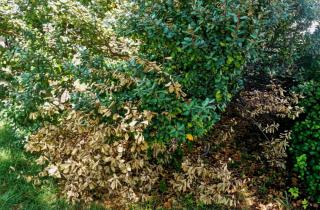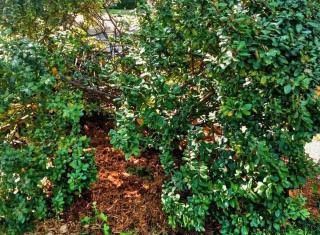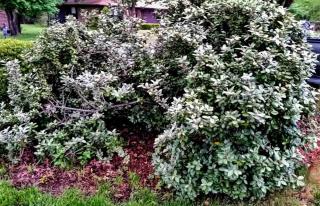

Silverberry is a resilient shrub, but in this case tiny bird droppings nearly killed it… Numbers is the operative word here: when an entire flock sets down on a shrub or tree too often, it suffers dearly. Droppings and constant bird traffic can kill a tree!
Keith Hall, a Nature & Garden contributor, shares a rare experience with us.
Silverberry, a member of the Elaeagnus family, stands out against most other shrub types. Indeed, it’s very hardy, resilient and weather-worthy. Its relative, Russian olive, is even invasive because it’s so hard to kill off.
But here, a healthy, well-settled in bush was teetering on the brink of survival by a simple flock of sparrows.
 For some reason, a well established silverberry bush started dropping new growth and the once solid bush saw entire branches turn dry and die. Yard-long branches of old growth yellowed and browned into a crisp, crackly mess while other branches seemed unscathed.
For some reason, a well established silverberry bush started dropping new growth and the once solid bush saw entire branches turn dry and die. Yard-long branches of old growth yellowed and browned into a crisp, crackly mess while other branches seemed unscathed.
Disease always starts somewhere, but other silverberry bushes in the near vicinity didn’t show the slightest hint of damage.
Silverberry is a type of bush that normally out-competes neighbors for water and nutrients. It is quite drought-resistant.
This particular bush, though, had two hawthorn bushes and two other trees within a ten yard (ten meter) radius. Together with a two-month heat wave, these plants certainly exerted competition for water, resulting in possible water stress for the silverberry.
However, Keith, with quite a bit of foresight, watered the bush abundantly, which probably saved the bush in the end.
Two clues sent the investigation off in an entirely different direction:
Over a hundred birds seemed to fly in and out of the bush on a daily basis. They were flying to and from the silverberry shrub on the way to a loaded bird feeder that was a couple yards out. This shrub just happened to be the nearest spot for cover when approaching the feeder from further out.
 The sparrows, while they didn’t roost in the bush overnight, certainly spent a large part of the day there, zooming in and out of the shrub to the point of carving out a tunnel in the previously solid leaf cover. Branches at entry points to and from the shrub grew stunted leaf buds or died off under the constant wing pressure.
The sparrows, while they didn’t roost in the bush overnight, certainly spent a large part of the day there, zooming in and out of the shrub to the point of carving out a tunnel in the previously solid leaf cover. Branches at entry points to and from the shrub grew stunted leaf buds or died off under the constant wing pressure.
At the foot of the shrub and along the branches, uncountable droppings showed that these birds were definitely enjoying their free lunches.
Usually, birds never single-handedly kill trees. As with all things natural, a combination of factors reach a tipping point over time.
In this case, the following weakened the shrub in the first phase:
And the crucial blow was the flock of sparrows.
Accumulated droppings from hundreds of birds cause extreme concentrations of nitrogen in soil. Since a heat wave and drought were at their peak, any amount of water was loaded with concentrated nitrogen ions. This triggers imbalances in the root and sap system. Some roots send sap up to specific branches, and those branches die off wherever excess nitrogen upsets their balance.
Watering abundantly washed most droppings out, which probably saved the bush.
All in all, too much “fertilizer” burned roots off the mature silverberry, as happens to seedlings when planting in soil that is too rich. This also happens wherever chickens are permanently penned in a coop under trees.
Knowing the problem is half the solution. Steps were taken to deal with the birds and help the bush recover.
Removing or emptying the feeder is the most effective, followed by the net and fishing line. Birds don’t like getting entangled in such near-invisible obstacles.
The long-term solution is to plant berry trees and shrubs in separate areas of the garden. This adds sources of food over time as seasons come and go. Birds change flight patterns and don’t shed droppings in a single spot.
 prune off dead branches
prune off dead branchesPruning keeps roots from sucking up too much water from areas with too much nitrogen, and clears space for new growth.
Watering washes out excess nitrogen. This is one way to save a tree from poisoning.
Mulching with wood chips serves a double purpose. First of all, fungus that decompose wood chips consume a lot of nitrogen, so they absorb nitrogen. Second, mulch releases nutrients that help shrubs bounce back.
In the end, since the issue was solved early, the bush grew back to its full shape by the following spring. Case closed!
Read also:
Here is an update on the condition of my bush. The leaves started growing about a month after I moved the bird feeder, but the birds were still using the bush. So I moved the feeder in to the rear yard, yes I was feeding the birds and still am. Here in this part of Texas we have a month or two of winter. 2 or 3 months of fall. And 3 or 4 of spring, 4 of summer, bugs are hard to find in summer they all go deep in the ground and are in the ground in fall and winter. So supplying feed for them is basically a year round thing. When bugs are plentiful the birds ignore the feed.
Okay that’s why I feed them but I don’t want them to destroy the bushes. So I now have all feeders out back. We just had a month and a half of rain the bush is really looking like its trying, but I noticed that the small sparrows and wrens are still using the bush, the only thing that is for birds in the area of the Bush is a shallow birdbath the size which is perfect for wrens and sparrows. Now that is moved and in the backyard too. I’m not moving the other birdbath it’s a deep one for doves and larger birds that don’t fly in the bush they use the trees. The bush is hopefully rid of the birds now.
Well it figures, birds gone, bush doing good, mulch down. So… losing half the branches again this spring. !!!! But I think I have it figured out why. Because the mulch is being used by them dang stray cats as a litter box.
I was wondering where that smell was coming from. Now I have to fight the cats there too. 8-(
Hah! Nature has a way of always keeping us on our toes!